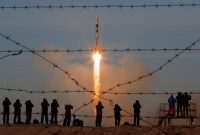Support strong Canadian climate journalism for 2025
A global agency that sets rules for the seas is studying the environmental effects of more and more rocket stages that may contain toxic fuel dropping into the world's oceans.
The International Maritime Organization's concern comes after Inuit groups expressed anger over Russian launch stages splashing down in Canadian waters hunters depend on for food. It also follows research detailing a satellite industry growing worldwide despite little understanding of its consequences.
"Right now we are just starting an information-gathering phase," said Linda Porebski, a senior Environment Canada official who heads one of the maritime group's scientific bodies, which has just met in Vancouver.
"We are generally aware there are an increasing number of launches, and that there are booster rockets that fall, and that there is potentially fuel on board."
General awareness is all there is of the rapidly expanding industry, said David Santillo, a Greenpeace-funded biologist at the University of Exeter in the United Kingdom.
"We can't get very far in terms of knowing exactly what's going to be launched, how much of that is going to come down in the oceans, what material it's going to be carrying, how much excess fuel," he said.
"It's very hard to get that information."
Greenpeace decided to dig into the issue in 2017 following Inuit concerns that a Russian-launched rocket carrying a satellite owned by the European Space Agency would drop a stage in the North Water Polynya, one of the Arctic's most biologically productive areas.
Academic research found at least 11 such splashdowns since 2002. All of those rockets were fuelled by highly toxic hydrazine.
Documents released under access-to-information laws suggest there have been others. A launch site in French Guiana also uses trajectories that drop debris in the Arctic. "Residual hazardous fuel may still be in tanks on re-entry," the documents say.
They list 39 sites around the globe. Santillo's research found at least 30 companies sending satellites into orbit, some with plans for weekly liftoffs. A company in Canso, N.S., has applied to launch hydrazine-fuelled rockets.
Little is public about their trajectories or possible debris, Santillo said.
Although rockets routinely carry a supply of extra fuel, officials dismiss the risk. The European Space Agency has said leftovers are burned up on re-entry.
Canadian government documents echo that.
"Hydrazine is unlikely to still be present by the time the debris falls to Earth," wrote one staff member at Global Affairs Canada. Another called the likelihood of rocket fuel entering the oceans a "false narrative."
Others aren't so sure.
"It is somewhat possible that upwards of 10 per cent of residual fuel could potentially be present in the upper stage of a launch vehicle," wrote one official from National Defence, although she added it was "quite likely" the risk would be "very low."
Porebski wrote in response to another email: "I am not sure I share your assessments of the claims of the risks being overblown, especially given the potential for great increases in traffic ... certainly there is a lack of tracking or hard data to support any real conclusions about risks or impacts."
Research from Russian launch sites suggests some fuel does reach the water's surface.
Hydrazine is gradually being phased out of most space programs, but Santillo said other fuels are also harmful.
"There is general concern. The difficulty is getting information on what those alternative fuels are and how they would behave in the environment."
Contaminants could include other materials such as battery components, Santillo said.
"Each of them has a cumulative environmental burden."
Porebski said her group has requested information from governments as well as international bodies involved with space. She said it's hoped there will be preliminary data by June.
"We're looking at starting a dialogue on how we would go forward."
Santillo said the space industry is the only one left using oceans without any kind of regulation. Now's the time to reconsider, he said.
"The earlier there can be this type of thinking, the more chance there is that we can achieve something a bit more sustainable than launching a vehicle and forgetting about it."






Comments